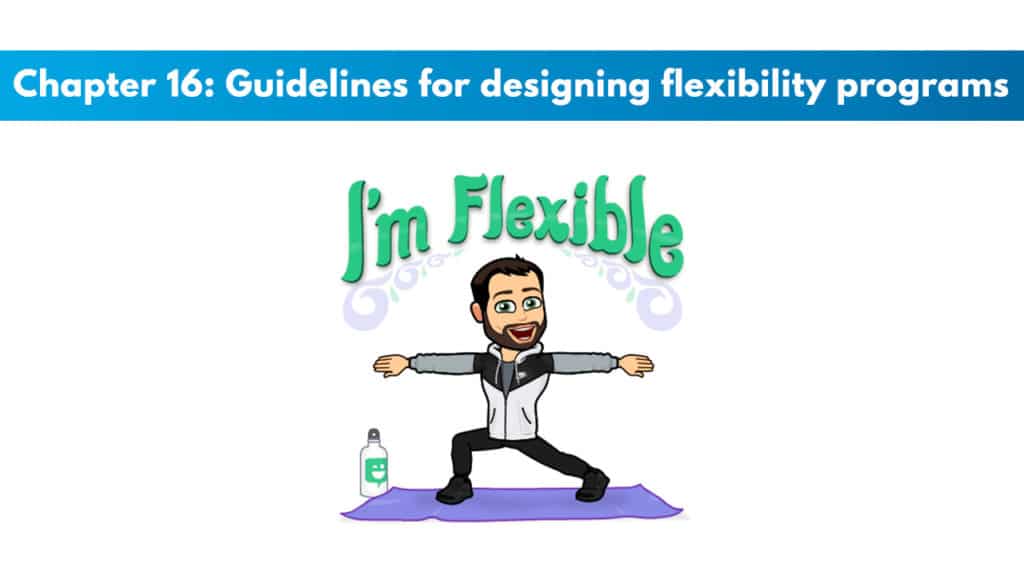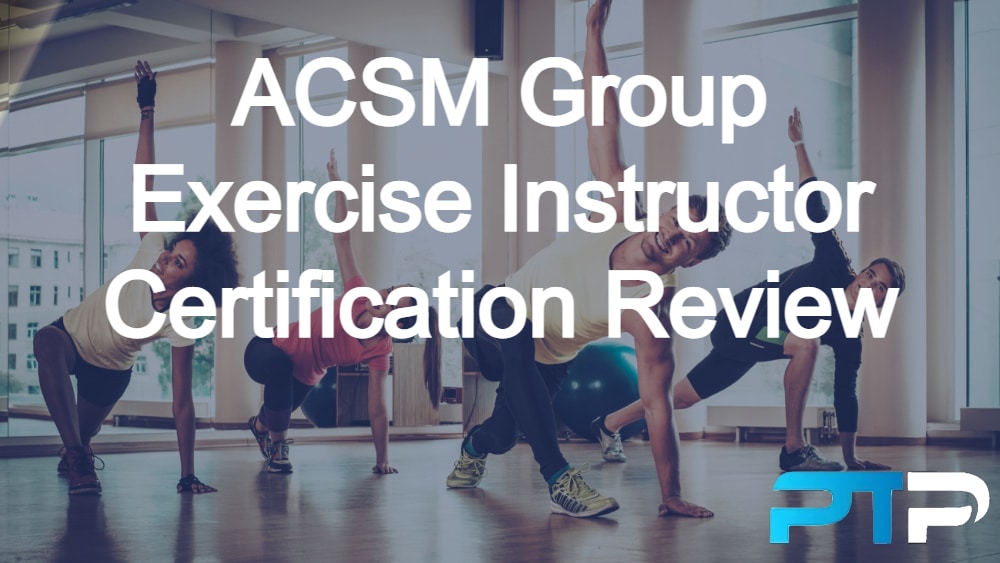
Get your copy of the ACSM CPT exam cheat sheet. It helps immensely for studying for the exam.
Make sure to check out Trainer Academy for premium ACSM CPT study materials. They will reduce study time by 50% and have an exam pass guarantee. Read my full review on them here. You can save $100 on their MVP study system with the code: PTPSUB
Chapter Objectives:
- Know details regarding flexibility influencing factors.
- Know the risks and benefits of training flexibility.
- Find out how we can evaluate flexibility.
- Know methods for stretching.
- Know the precautions for people that have health concerns.
- Make a program for flexibility while using the principles of FITT-VP.
Determinants of Flexibility
Some of the influencing factors for flexibility are things like joint structure, soft tissue health, antagonistic muscle length, and the temperature of the stretched tissues.
There is a possibility that poor soft tissue integrity, disease, and injury will contribute to hypermobility and excessive ranges of motion for joints.
Age
The ability to move through the full range of motion will decrease as we age. This is about 25 – 30% less by the age of 70. These decreases depend entirely on the joint itself. The loss in the range of motion can be many different things. Changes happen within the collagen, showing more rigidity between the fibers. The joint becomes more resistant to bends when this happens. We also see reduced elastin and deterioration of the cartilage, synovial fluid, muscles, and tendons. The decreased activity also may accelerate the losses in the range of motion.
Sex
Many studies show that women are more flexible than men due to skeletal architecture differences and the morphology of connective tissues, and a few differences in hormones. Some examples are things like women having broader and shallower hips which would have a great range of motion for their hip joints.
Physical Activity History
The activity status of someone has a major impact on their flexibility. An active person will almost always be more flexible than a sedentary person. Many of these can be sport specific, like the greater wrist flexibility we see in volleyball players over sedentary people and the hip flexibility being greater for hockey players.
Benefits and Risks of Flexibility Training
The current science often gives professionals more questions to ask than answers regarding the risks and benefits that come from stretching.
Benefits
Improved Range of Motion: These improvements can be seen relatively quickly.
Exclusive PTP CPT Offers |
||
|---|---|---|
Gold Standard Cert | Most Popular Cert | Best Study Materials |
A Good Option | A Good Option | Best CPT for you?  |
Improved Performance of Activities of Daily Living: Living independently in a community will depend on someone’s ability to do daily tasks, and by working on flexibility, we can increase our abilities.
Joint Hypermobility: This is also known as congenital laxity of the ligaments and the joints. This is shown with extreme ranges of motion and some pain.
Decreased Strength: Flexibility exercises might reduce power and strength acutely. It is recommended that these flexibility exercises be done after both exercise and sport activities where both strength and power are of importance for performing.
Ineffective for Preventing Injury: It is often promoted to help reduce the risk of injury, but there is no real link between training and reductions in musculotendinous injuries. It is also true that the more explosive some skill is, the more reliant on a good range of motion and flexibility it is.
Temporary Effects: The length of time that increases in flexibility lasts after stretching is not as long as trainers believe. The increases are actually very short lived.
Evaluating Flexibility
Assessing the clients’ range of motion is important for making an exercise program. These are the pieces of information that are most important to look for:
- The initial range of motion before starting the program.
- The baseline measures that plans can be formed for future goals of exercise.
- The immediate range of motion feedback.
- The Identification of any muscular imbalances.
Types of Stretching
Static
This is the most commonly used method for improving flexibility. It can be done both actively and passively and it is made up of slower movements into a position and then holding that spot for some seconds at a peak tension. This is usually done with a 10 – 30 second hold for one rep.
There is not a lot of agreement in the community for how long a stretch should be held, but again, somewhere in the range of 10 – 30 seconds is optimal.
Dynamic
This is a form of stretching that uses movement and muscle tension development. These are performed as active stretches only. It is very close to sport or function specific warmups. Dynamic stretching aims to move certain joints in controlled ways in a normal range of motion to minimize injury risks. The stretches should begin with a small range of motion and then progress to a full one.
This type of stretching may be confused with ballistic stretching, which is the use of the momentum of the body to produce a bounce or jerk like movement for the obtaining of peak tension or stretch.
Proprioceptive Neuromuscular Facilitation
This uses both active and passive stretching techniques that will improve the range of motion of joints. This sees both a trainer and their client working to do it.
Exclusive PTP CPT Offers |
||
|---|---|---|
Gold Standard Cert | Most Popular Cert | Best Study Materials |
A Good Option | A Good Option | Best CPT for you?  |
PNF stretching elicits a response from the neuromuscular system that relaxes. This happens in the prime mover, antagonist, and synergist.
Rationale for Flexibility Training
Sports and other physical activities require full and pain free movement for joints in their range of motion. However, very little scientific evidence is available to prove or disprove the many common stretching habits that even athletes have.
Designing a Flexibility Training Program
Warm-up
Stretches can be done at any point during exercise if the body has been warmed up properly. This means that it should always be preceded by some form of exercise warm up, just like the other types of exercise in the last two chapters. This will increase the temperature in the body and make things more elastic.
Breathing
The right breathing techniques are helpful to relax clients and allow movements into comfortable positions. Here we will not be doing the Valsalva maneuver.
Posture
The right posture is needed to properly stretch the muscles or muscle groups for the specific stretch.
These are some of the common reminders for the right postural alignment:
- Keep a neutral spinal position.
- The shoulders remind back and away from your ears.
- The hips will be neutral and level.
Precautions for Individuals with Health Concerns
There is very little reason for avoiding flexibility training in apparently healthy people.
Arthritis: About 50 million people have arthritis in the united states. There is also a higher prevalence in women than in men. Arthritis is an inflammation of a joint that results in damage occurring to the joint structure itself. These are the guidelines we use when training clients that have arthritis:
- Stay away from strenuous exercise when having acute flair ups and inflammatory periods. But also, it is acceptable to move joints in their full range of motion when this happens.
- Encourage people with arthritis to stretch during the time of day when pain is not as bad or in conjunction with the peak activity of the pain medications.
- If clients have more joint pain after training, the session might need to be modified next time.
- Avoid overworking people that have taken medication that is anti-inflammatory.
- Talk with the clients about wearing shoes that absorb shock well and have good stability.
- Functional activities will assist the most in activities of daily living.
Muscular Imbalance
Many people have some form of muscular imbalance, possibly creating alignment problems and injuries.
The use of repetitive movements, bad posture, and weakened or tightened muscles will cause these, too.
Osteoporosis
This disease affects the bone mineral density, reducing it, deteriorating the bone microarchitecture, and then having the bones becoming fragile and susceptible to being fractured.
People with osteoporosis should avoid these things:
- Bending forward
- Extending their back
- Plough pose
- Supine Spine rotation and twisting
Hip Fracture or Replacement
Clients with these should avoid these flexibility exercises involving excessive:
Hip flexion
Hip adduction
Internal rotation of the hip
Flexibility Program Development
Frequency
Flexibility is recommended to be done for 2 – 3 days per week, but the most effective is reached when done daily.
Intensity
Stretches should feel some mild discomfort without having some pain. This is all very relative to the client that is doing the stretch.
Time
The stretches need to be held for a time between 10 and 30 seconds. But when looking at PNF stretching, it is recommended to follow 3 – 6 seconds.
Type
General stretching should be done for the improvement of flexibility. This means that the major muscles and tendons of the body will be stretched. The book contains some examples throughout box 16.2.
Volume
It is recommended to do 60 seconds of stretching per joint and then repeat the exercise for two to four times. So these 2 – 4 times will add up to the suggested 60 seconds.
Progression
Optimal progressions are not known.

 Have a question?
Have a question? 



![ACSM Exam Prep [year] - How to Pass the ACSM Exam on the First Try 10 ACSM Exam Prep](https://www.ptpioneer.com/wp-content/uploads/2019/08/ACSM-Exam-Prep.jpg)
![FREE ACSM Study Plan, Study Calendar + Blueprint [year] 11 ACSM Study Plan](https://www.ptpioneer.com/wp-content/uploads/2022/12/ACSM-Study-Plan.jpg)
![FREE ACSM Study Guide [year] - Studying Made Simple 12 FREE ACSM Study Guide](https://www.ptpioneer.com/wp-content/uploads/2019/11/FREE-ACSM-Study-Guide-1.jpg)
![FREE ACSM Practice Tests [year] - 180+ Practice Questions 13 ACSM Practice Exams](https://www.ptpioneer.com/wp-content/uploads/2022/12/ACSM-Practice-Exams.jpg)
![FREE ACSM CPT Flashcards [year] - Over 950+ Flashcards! 14 ACSM Flashcards](https://www.ptpioneer.com/wp-content/uploads/2022/12/ACSM-Flashcards.jpg)


Tyler Read
PTPioneer Editorial Integrity
All content published on PTPioneer is checked and reviewed extensively by our staff of experienced personal trainers, nutrition coaches, and other Fitness Experts. This is to make sure that the content you are reading is fact-checked for accuracy, contains up-to-date information, and is relevant. We only add trustworthy citations that you can find at the bottom of each article. You can read more about our editorial integrity here.